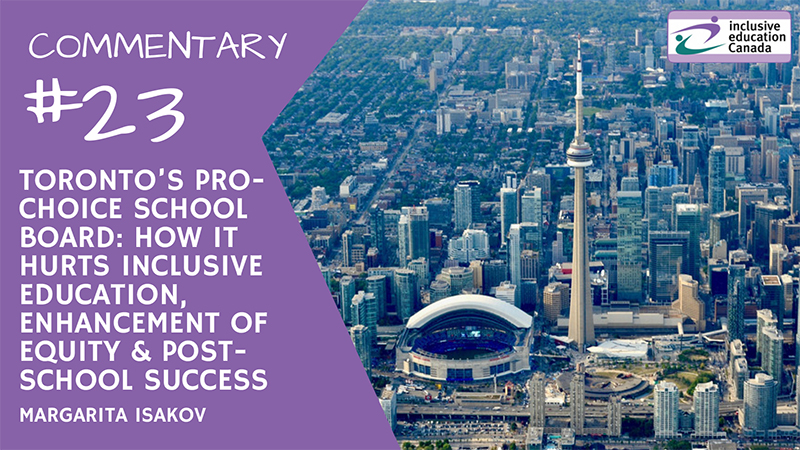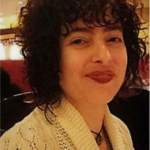 National Inclusive Education Month Commentary #23
National Inclusive Education Month Commentary #23
Toronto’s Pro-Choice School Board: How it hurts Inclusive Education, Enhancement of Equity & Post-School Success
By Margarita Isakov, Inclusion Advocate and TDSB SEAC representative for Integration Action for Inclusion -Toronto Chapter
An Enhancing Equity Task Force (EETF) was created by Toronto District School Board (TDSB), Canada’s largest school board with 246,000 students in 583 schools throughout Toronto. The Task Force was to inform the work of their staff and Board of Trustees; it consisted of TDSB staff, school trustees, students, families and community members. Click here to read the full report.
On January 31st, 2018, the TDSB Director of Education’s (Dr. John Malloy) responded to the EETF report, by saying we will:
- Continue to offer choice through specialized schools and programs and improve access to the programs that all students need; (my emphasis: programs should not be confused with placement)
- Continue to support students with special education needs, including Gifted, through parent choice of home school placement or congregated sites (my emphasis: congregated=segregated);
- Continue to study the impact of our programs, practices, and structures on the achievement and well-being of our students.
This administration has created a school board of “choice”, not only for parental choice to access segregated placements outside of their own neighbourhood schools, but for the “choice” of regular classrooms teachers to engage in appropriate and much-needed professional development (although the Director’s commitment to ensuring one teacher out of every school along with VPS and Principals will receive training about inclusive and equitable classrooms and schools, this is not enough).
This board claims that inclusive education and Universal Designs for Learning is building momentum; if this is true, than it would suffice to say that the board needs to find professional development important enough to mandate it to all school staff. Furthermore, studies cite that teachers felt that inclusion develops tolerance and respect for differences while those same teachers felt that they did not have sufficient training, knowledge, skills or resources. We need to harness those positive teacher attitudes and beliefs (and those with negative biases), boost their confidence and knowledge when they experience first-hand how practical solutions and strategies can continue to promote inclusion in regular classrooms. Teachers, who were shown to successfully socially include students, held an interest in the students’ background, maintained close communication with parents, held high expectations for students, and provided support for students to facilitate success (Ben-Yehuda, Leyser & Last, 2009).
Let’s look at the “choice” parents are making; are parents really choosing, or reacting to negative messaging from the medical profession, from therapists, psychologists, and principals? The messages are “Your child can never achieve at par with others” “will not be welcomed by teachers” “your child is too disruptive, or distressing to other students”, “your child will never be independent, have friends, or have a “normal” life”.
Unfortunately, I have been privy to all these overt statements made by TDSB staff to the families I served, statements of presumed incompetence or inability to achieve one’s full potential. If I have witnessed just one of these conversations in a single meeting, that’s only a small percentage of what families hear day after day, month after month, year after year – until families feel that the only “choice” is segregation. They begin to believe that “my child will be welcomed, understood, supported, accommodated for, well-cared for, and loved – over there!!”
Let’s talk about the educational research commissioned by this board, to further the case for inclusive education (Parekh, G., A Case for Inclusive Education, 2013):
- “The benefits of segregated placements as well as deficit oriented pedagogical approaches have been widely challenged (Mitchell, 2010).
- Gordon Porter (an inclusive education expert) suggested that with a board the size of the TDSB, setting up model schools of inclusion within each quadrant of the board might be a vital piece to moving the system forward. (Dr. G. Porter, personal communication, February 1, 2013).
- Classroom and social interactions are key to student learning (Rix, Hall, Nind, Sheehy & Wearmouth, 2009). When classrooms are structured in a way that prevents the natural occurrence of social interactions between students or limits participation, certain groups of students are disadvantaged.
- Research studies (Crawford, 2005; Myklebust & Batevik, 2009) demonstrate the importance of inclusion for students with low functional skills and/or intellectual disabilities. When severity of impairment was controlled, results from both studies indicated that students who were taught in inclusive, general education classes were more likely to find employment and be economically independent post-high school.
- One of the key proponents of inclusive education is the reduction of segregated classes and the promotion of mixed ability grouping both between and within classes. Houtveen and Van de Grift (2001) highlight drawbacks of ability grouping by stating that placement in low-ability groups imposes low expectations on students; that ability groupings often mirror social, ethnic, and class divisions; that assignment to an ability group is often a permanent allocation; that there is often less instruction delivered in lower-ability groupings compared to mixed-ability groupings; and that segregated low achieving students are further disadvantaged based on a lack of access to positive role models and social stimulation.
- Aside from minimal increases in student reported-confidence for typical students taught in inclusive classrooms, the study was not able to determine any effect on typically developing students in inclusive classrooms (Ruijs, Van der Veen, & Peetsma 2010).
Research findings simply stated: better outcomes for students with exceptionalities and no negative impact on students without exceptionalities.
Malloy wants to “Continue to study the impact of our programs, practices, and structures on the achievement and well-being of our students”. Yet the studies already exist along with countless empirical evidence from TDSB families whose children are/were in segregated placements. Why the need for further redundant educational research?
Current Ontario (IPRC) policies and procedures continue to contribute to an inequitable, segregating “Match, Batch and Dispatch” model of service delivery and decision-making. This approach is antiquated, lacks innovation, boldness, progressive thinking (Universal Access: equal opportunity, and research-based accessible instruction: Universal Design for Learning), and creativity. When an inclusive education is delivered well in local neighbourhood schools, with all the appropriate instructional and environmental designs in place (under the OHRC legal standard Duty to Accommodate), and attention to social learning models (described above) there were positive in-school and post-school outcomes for students with Special Education Needs and those without.
How can an inclusive model be shaped in this board when fully segregated schools, segregated class placements, specialty schools and optional attendance continue to exist?
As a former TDSB resource staff member, and current advocate for education, I have worked closely with hundreds of families. Those families with whom I’ve reconnected years later, and were offered segregated school placements (in these cases, Beverley and Heydon Park Schools) and felt they had no choice but to accept, were unhappy, distressed and disenchanted by the empty prospects that their children were now faced with.
Their children did not have enough credits for post-secondary; did not have any prospects for future employment; independent or semi-independent living; and had no same-age friends or social networks. The stark reality sets in: their children are not prepared for the real world and will rely on millions of ministry dollars for the rest of their lives. All options, except full ministry-funded supports, are closed to them, and those who have no informal support, who rely on MCSS funding will be left languishing on Passport and group home/institution waiting lists. TDSB has failed these families and will continue to fail future graduating students.
I understand the effects of segregation first-hand. I was placed in my school’s basement for my education with an unskilled EA. If it wasn’t for my own self-advocacy and the help of a teacher-librarian, my future could have been very different with fewer prospects. It was because the administration knew my mother came from low socio-economic status, had low English fluency, and had bigger problems on her plate. I also spent some of my school years in Winnipeg; the First Nations languages, culture and stories were always woven into the curriculum. A TDSB teacher with whom I team-taught, incorporated the Talking Stick and First Nations culture into her second-grade group Circles.
The TDSB approving a separate First Nations-centric school (or any other –centric school), just spotlights the failures of this board to reflect all cultures, abilities, races, languages and identities in our neighbourhood schools where we live, and points to an education system that is catering to an open market culture for the marginalized and privileged alike.
I made a plea to DOE Malloy: Listen to the research, it speaks volumes, literally. Listen to the underprivileged families who have softer voices. Listen to the mistakes of the past and boldly correct them. Create an education system that is human-centric. Bring school neighbourhoods and communities back together instead of fragmenting and rending them apart; close the gap between the haves and the have nots – because families and school staff are stronger when we ALL work together and support one another for the brighter future of our children.
Because as a great philosopher once said: “The lack of imagination is one of our greatest handicaps.”
 Margarita Isakov is a staunch supporter and promoter of quality, equitable and accessible inclusive education, and full engagement and participation of all children and families in their communities. With 25 years in the field: as an inclusion coordinator (Toronto Parks and Recreation), preschool inclusion facilitator (Mothercraft K.I.D.S.), special education resource staff with both Toronto school boards, and Resource Consultant and advocate for families of children with extra support needs in early childhood programmes, Margarita is devoted and passionate about her cause. She holds a Masters Degree in Education from OISE/University of Toronto, and is also the Integration Action for Inclusion -Toronto chapter representative on TDSB SEAC.
Margarita Isakov is a staunch supporter and promoter of quality, equitable and accessible inclusive education, and full engagement and participation of all children and families in their communities. With 25 years in the field: as an inclusion coordinator (Toronto Parks and Recreation), preschool inclusion facilitator (Mothercraft K.I.D.S.), special education resource staff with both Toronto school boards, and Resource Consultant and advocate for families of children with extra support needs in early childhood programmes, Margarita is devoted and passionate about her cause. She holds a Masters Degree in Education from OISE/University of Toronto, and is also the Integration Action for Inclusion -Toronto chapter representative on TDSB SEAC.
